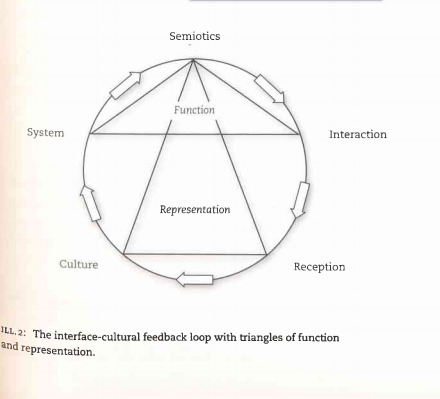User:Δεριζαματζορπρομπλεμιναυστραλια/Graduatreadings/intcriticismaarhus: Difference between revisions
No edit summary |
No edit summary |
||
| (8 intermediate revisions by the same user not shown) | |||
| Line 1: | Line 1: | ||
'' | ''Soren pold: Interface PercePtion The Cybernetic Mentality and Its Critics:Ubermorgen.com'' | ||
Interface PercePtion The Cybernetic Mentality and Its Critics: | [[File:Aaaaaaaaaaaaaaaaaaaa.png|150x150px|framed]] | ||
Ubermorgen.com'' | [[File:Aaaaaaaaaasaaa.png|150x150px|framed|left]] | ||
'''we do not only see the | |||
worid with our eyes; our seeing is also accomplished and takes | |||
effect in a way that is governed by semiotic and material media, | |||
which are historical constructions in our reality. | |||
We may still see | |||
with the physiological eyes of the hunter and gatherer, but what we | |||
perceive has changed a great deal when we watch reproduced images | |||
or film or read a text''' | |||
Walter Benjamin suggested in the r93os that the mode of human perception | |||
changes historically. Media. | |||
how media and representations challenge and change ourway of perceiving | |||
and simultaneously incorporate certain modes of perception in | |||
their own technological and material form. | |||
A current significant example of this is the rybernetic interface. | |||
the contemporary interface also incorporates cybernetic feedback and interaction. | |||
it is important to follow this interface | |||
perception in order to understand our current social, political | |||
and cultural reality. But when we look at an interface, we only see | |||
half of it, since the machinic, cybernetic part is largely hidden from | |||
our senses, though it still has effect | |||
Latest revision as of 23:05, 29 November 2014
Soren pold: Interface PercePtion The Cybernetic Mentality and Its Critics:Ubermorgen.com
we do not only see the
worid with our eyes; our seeing is also accomplished and takes
effect in a way that is governed by semiotic and material media,
which are historical constructions in our reality.
We may still see
with the physiological eyes of the hunter and gatherer, but what we
perceive has changed a great deal when we watch reproduced images
or film or read a text
Walter Benjamin suggested in the r93os that the mode of human perception changes historically. Media.
how media and representations challenge and change ourway of perceiving
and simultaneously incorporate certain modes of perception in
their own technological and material form.
A current significant example of this is the rybernetic interface.
the contemporary interface also incorporates cybernetic feedback and interaction.
it is important to follow this interface perception in order to understand our current social, political and cultural reality. But when we look at an interface, we only see half of it, since the machinic, cybernetic part is largely hidden from our senses, though it still has effect


